
The Crambidae are the grass moth family of lepidopterans. They are variable in appearance, the nominal subfamily Crambinae taking up closely folded postures on grass stems where they are inconspicuous, while other subfamilies include brightly coloured and patterned insects which rest in wing-spread attitudes.

The Pyralidae, commonly called pyralid moths, snout moths or grass moths, are a family of Lepidoptera in the ditrysian superfamily Pyraloidea. In many classifications, the grass moths (Crambidae) are included in the Pyralidae as a subfamily, making the combined group one of the largest families in the Lepidoptera. The latest review by Eugene G. Munroe and Maria Alma Solis, in Kristensen (1999) retains the Crambidae as a full family of Pyraloidea.
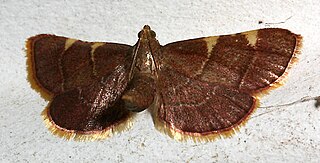
Hypsopygia olinalis, the yellow-fringed dolichomia, is a moth of the family Pyralidae. It is found in eastern North America.
Caristanius decoloralis is a moth of the family Pyralidae described by Francis Walker in 1863. It is native to North America, where it has been recorded from North Carolina, Florida and eastern Texas. It is an introduced species in Hawaii.
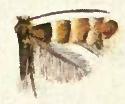
Chrysaster ostensackenella is a moth of the family Gracillariidae. It is known from Canada and the United States.
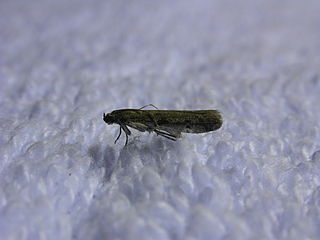
Phycitodes reliquella is a moth of the family Pyralidae described by Harrison Gray Dyar Jr. in 1904. It is known from North America where it is widely distributed in the east, including Alabama, Arkansas, Connecticut, the District of Columbia, Florida, Georgia, Illinois, Louisiana, Massachusetts, Maryland, Maine, North Carolina, New Hampshire, New Jersey, New York, Ohio, Oklahoma, Pennsylvania, South Carolina, Virginia and Ontario.

Aphomia terrenella, the terrenella bee moth, is a moth of the family Pyralidae. It is found in North America from Michigan, Ontario, Quebec and New York south to Georgia.

Epipaschia superatalis, the dimorphic macalla moth, is a moth in the family Pyralidae. It is found in eastern North America.

Dioryctria zimmermani, the Zimmerman pine moth, is a moth of the family Pyralidae. It is found from southern Canada and the north-eastern and Great Lakes areas of the United States. There is a disjunct population in eastern Nebraska.
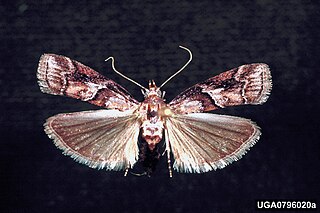
Dioryctria clarioralis, the blister coneworm moth, is a moth of the family Pyralidae. It is found in the eastern United States, including Florida, New Jersey and Virginia.
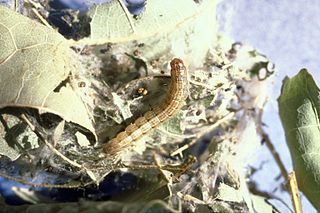
Pococera asperatella, the maple webworm moth, is a moth of the family Pyralidae. It is found in North America, including Alabama, Illinois, Massachusetts, Minnesota, New Hampshire, New Jersey, North Carolina, Oklahoma, Ontario, Pennsylvania, South Carolina, Tennessee, Texas, Virginia and Wisconsin.

Dioryctria albovittella, the pinyon tip moth, is a species of moth of the family Pyralidae. It is found in North America including New Mexico.
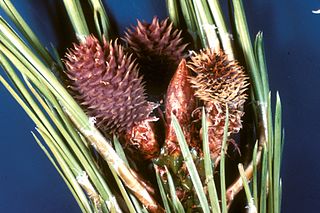
Dioryctria auranticella, the ponderosa pineconeworm moth, is a species of moth of the family Pyralidae. It is found in western North America from southern British Columbia south to California and Arizona, east to South Dakota and New Mexico.

Dioryctria ebeli, the south coastal coneworm moth, is a species of moth of the family Pyralidae. It is found in the US states of Florida, the southern parts of South Carolina, Georgia, Alabama, Massachusetts, and south-eastern Louisiana.

Dioryctria reniculelloides, the spruce coneworm, is a species of moth of the family Pyralidae. It is found from Nova Scotia to Alaska, south in the east to New York, and south in the west to California and New Mexico. It was recorded from China in 2009. Occasionally abundant, often in conjunction with epidemics of the spruce budworm, the spruce coneworm occurs through most or all of the range of spruce in North America, feeding on new foliage and cones of spruce, and often balsam fir. When abundant, it can be a serious pest "particularly on white spruce".

Dioryctria disclusa, the webbing coneworm or rusty pine cone moth, is a species of moth of the family Pyralidae. It is found in North America from New Brunswick to Florida, west to Texas and north to Manitoba.
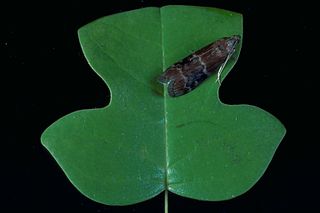
Euzophera ostricolorella, the root collar borer moth or tuliptree borer, is a species of moth of the family Pyralidae. It was described by George Duryea Hulst in 1890. The species is found in the United States from Arkansas and Louisiana to northern Florida, north to Michigan and New York.

Heliomata cycladata, the common spring moth, is a moth of the family Geometridae. The species was first described by Augustus Radcliffe Grote and Coleman Townsend Robinson in 1866. It is found in eastern North America, with records from southern Ontario, southern Quebec, Maine, New Hampshire, Michigan, Wisconsin to South Carolina, Georgia, Alabama, northern Mississippi and Arkansas.
Dicymolomia opuntialis is a moth in the family Crambidae. It is found in North America, where it has been recorded from California.
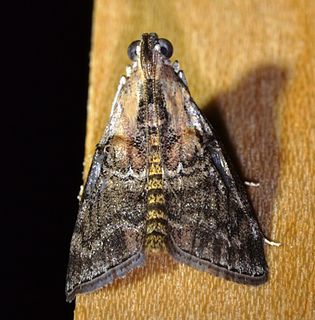
Pococera expandens, the striped oak webworm moth or double-humped pococera moth, is a moth of the family Pyralidae. It is found in North America, where it has been recorded from Arizona, Arkansas, British Columbia, Georgia, Illinois, Indiana, Iowa, Kentucky, Louisiana, Maine, Manitoba, Maryland, Massachusetts, Mississippi, New Brunswick, New Hampshire, New Jersey, New York, North Carolina, Ohio, Oklahoma, Ontario, Pennsylvania, Quebec, South Carolina, Tennessee, Texas, Virginia, West Virginia and Wisconsin.

















